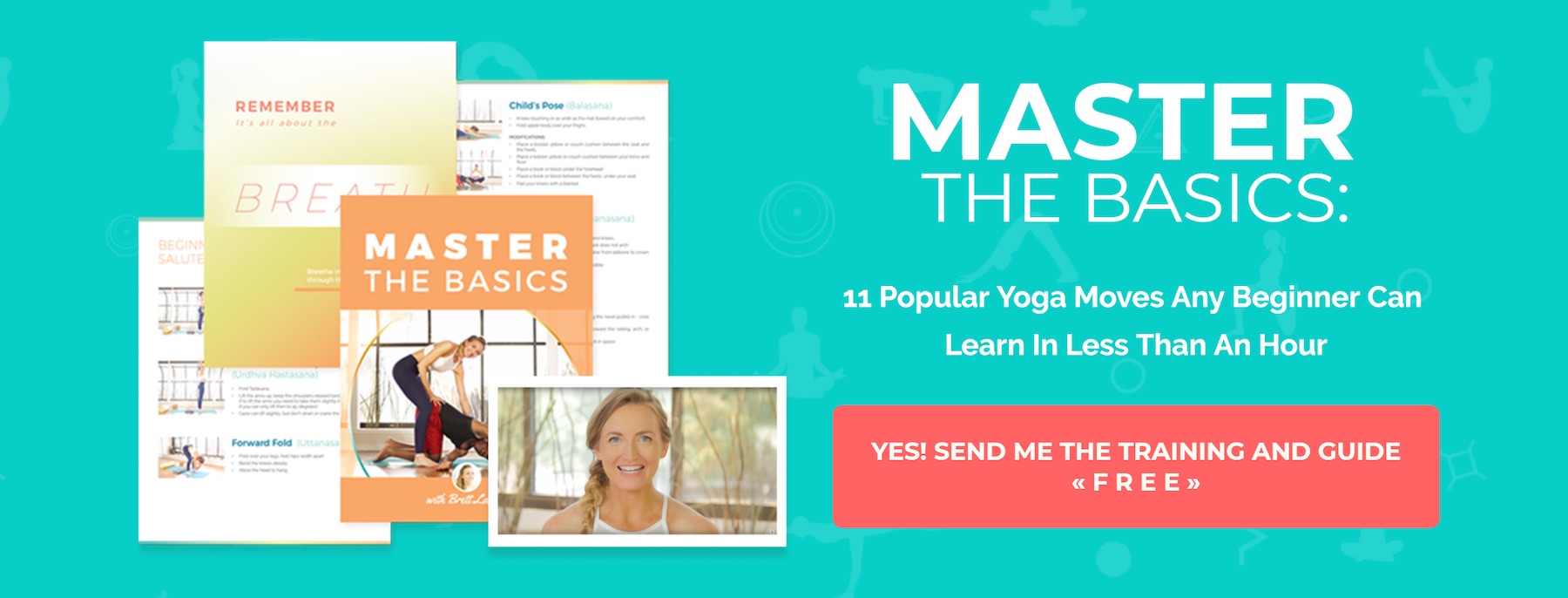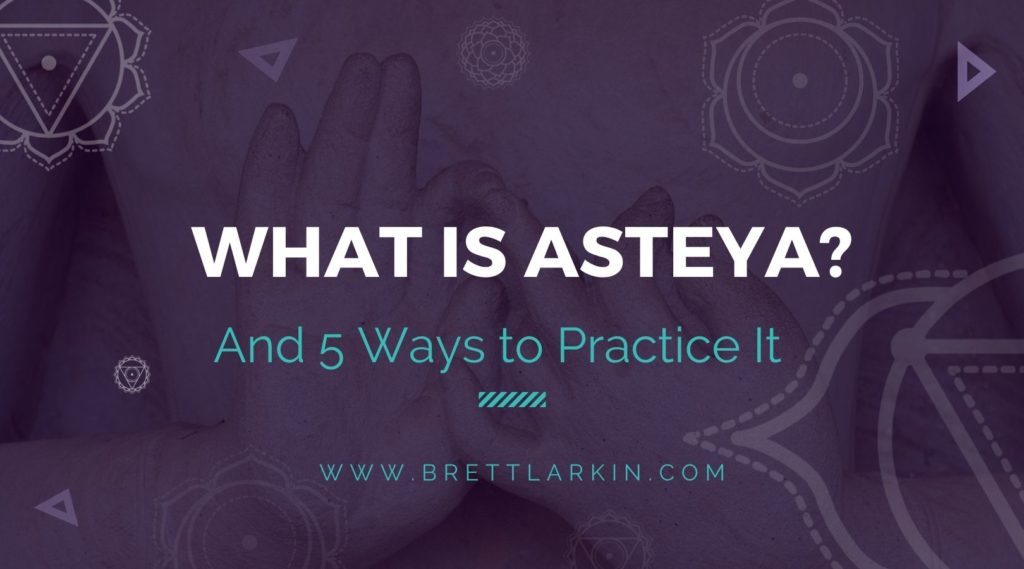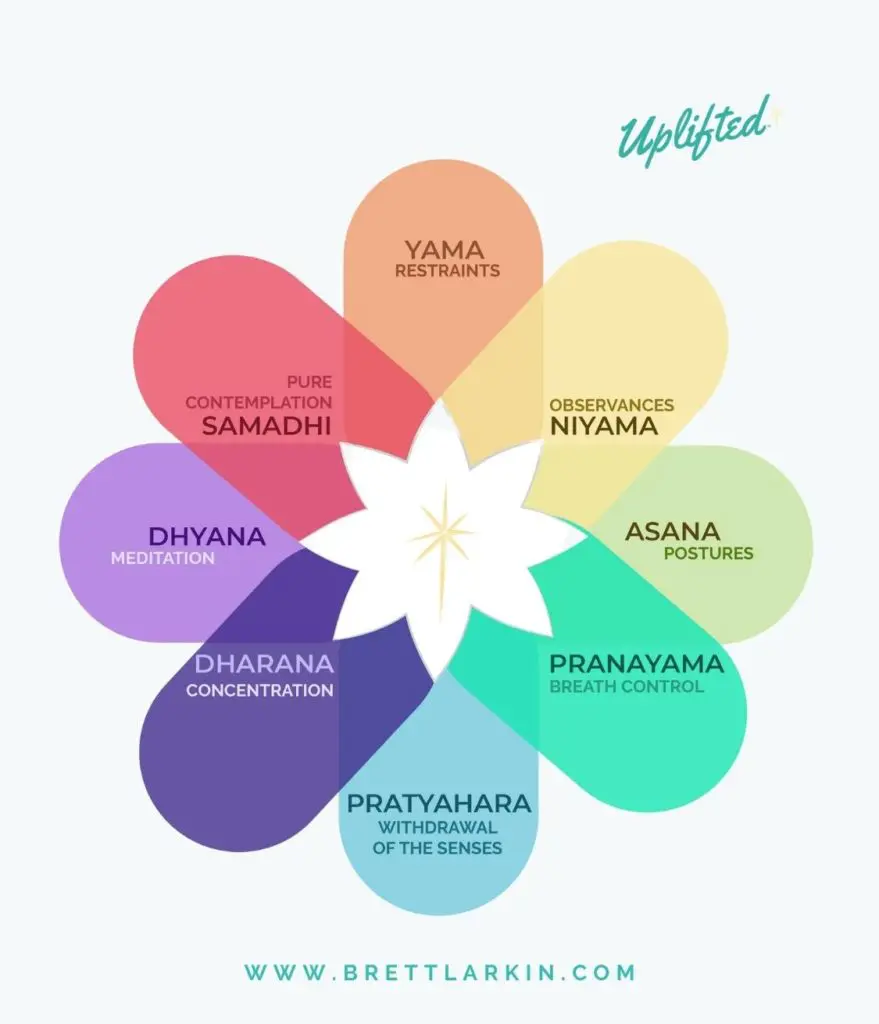When you were a kid, did you ever try to take something from a store just because you wanted it? Maybe an adult in your life had to return it to the store and explain to you that taking something that wasn’t yours without asking or paying for it was stealing.
We all had to learn that at some point.
Now, what if I told you stealing doesn’t have to do with just taking physical objects or money?
In yoga philosophy, that’s exactly the case. Specifically, in the third Yama of the eight limbs of yoga. And that’s what we’re going to get into here!
What Is Asteya Yama? Non-Stealing
Asteya is a Sanskrit word that translates to non-stealing and is one of the sacred virtues in Hinduism and Jainism.
Maharishi Patanjali incorporated the idea of asteya, via the Eight Limbs of Yoga, when he created his Yoga Sutras: a well-known text about yoga philosophy. Patanjali’s Yoga Sutras were guidelines for people to live by to help improve their overall well-being and happiness both on and off the mat.

Interpretations of Asteya and How it’s Applied
Sure, you’d probably agree that most human beings aren’t thieves. And while the surface level example of asteya (not stealing material possessions from other people or places) is usually easy enough to follow, there are other forms of stealing that can be a bit more challenging to always uphold.
You may even be unknowingly stealing in your daily life: taking credit for someone else’s work, hoarding more than you need, unintentionally taking things from work (pen, notepad). (Hey, if you didn’t know, you didn’t know — no judgment. We can all learn and improve.)
There are many layers to asteya and understanding how to actively practice can be beneficial to both your yoga practice and your daily life.
Asteya in Yoga: The Third Yama
First, remember that Asteya is just one of the five Yamas (or ethical principles) that Patanjali listed in his eight limbs of yoga. All five are ahimsa (non-violence), satya (honesty), asteya (non stealing), brahmacharya (self-control over impulses of excess), and aparigraha (non-coveting). You can separately apply each Yama to enhance your physical practice, but the ultimate goal is to experience the collective effect of practicing all five Yamas through the course of your life.
When combining non-stealing with yoga, remember to give yourself enough time (before, during and after) to wholeheartedly dedicate to your practice. For example, if you attend a group yoga class, being late (and all of the disruption that comes with it) is stealing time and peace from yourself, your yoga teacher, and your fellow yogis.
While on the yoga mat, moving from one asana (pose) to another, it’s common to become distracted by others in the class: one person is incredibly flexible; someone else is flowing through each pose with her eyes closed. It’s impressive and sometimes intimidating.
This awareness may produce thoughts of envy and insecurities about your own abilities. That insecurity may push you to do more than what your body can handle because you desire to look a certain way in a pose.
Pushing yourself beyond your edge for the purpose of perfection is not serving your needs and can result in unnecessary pain and suffering due to injury. Concerning yourself with what others are doing only distracts you from being in the present moment and feeling the beautiful complexities within your own body — it’s stealing your own peace of mind and enjoyment of the practice.
The fact is, every human being is unique and most will look differently in poses. Show yourself some love and compassion by setting healthy boundaries of thought and allow yourself to move through asanas (and life) at your own pace.
Why Practice Asteya On and Off the Mat
As you can see, non stealing has many layers and it’s useful to understand how you can exercise this virtue in any environment. After all, part of mastering your yogic journey is learning how to create balance in every aspect of your existence and not stealing plays an essential role in harmonious living.
Benefits of Practicing Asteya
The benefits of the intentional practice of asteya can produce improvements in your internal and external world which could expand your sense of overall well-being. Here are a few:
- Increased Self Awareness. When you’re able to take note of when and how you could be stealing in everyday life, you’re automatically improving your ability to exercise self-awareness.
- Boost Gratitude. Taking inventory of what you have will help you understand the magnitude of “blessings” around you that perhaps go unacknowledged in the everyday hustle.
- Creates More Space (Mental and Physical). When you let go of the things that you don’t need (possessions, limiting thoughts) you create space for the Universe to provide you with more of what you desire.
5 Ways To Interpret and Practice Asteya In Everyday Life
Though there are many examples, here are five practical and actionable ways you can incorporate asteya on a daily basis.
1. Not Stealing Time
Time is important to everyone. Whether you’re going to work, a social event, or taking time for yourself, do your best to be punctual. Honoring time for others and yourself can make plans run more smoothly and decrease unnecessary stress for all parties.
Here are some tips for how to actually do this:
- Create a calendar so you know what your commitments are
- Set an alarm as a reminder
- Leave earlier than you normally would to account for unexpected events like traffic
2. Not Stealing Peace
Have you ever walked into a room late, stressed, or just in a bad mood and noticed that everyone’s energy and attention immediately shifts to you?

You might almost feel like they were just talking about you but in reality, it’s likely that everyone just got a huge dose of whatever energy you walked in with. Sometimes your internal or external state can steal others’ peace.
These tips can help prevent that:
- Before leaving your house, or entering any place, take three deep breaths
- Set a harmonious intention for the day to help you show up with agreeable vibrations
3. Not Stealing Experiences
This is more about getting outside your comfort zone and overcoming fear. Doing something that’s outside your comfort zone (even a little) can open your mind to a greater depth of perspective, knowledge, love, and happiness.
Here are some ways you can try to provide yourself with more experiences:
- Try something new: take an alternative route to work, check something off your bucket list, take a new class
- Start conversations with new people you see often at work, the grocery store or yoga class
- Go on a trip with a good friend to a new place
4. Practice Abundance
Usually, the root cause of stealing is a feeling of lack or scarcity. Practicing abundance is a good way to take note of what you currently have and express gratitude for it. In most cases, you will find that you already have everything you need (food, clothing, shelter) which could decrease your desire to covet other people’s possessions or skills.
Try doing these practices:
- Make a list of everything and everyone you are grateful for
- Say the mantra “I am enough,” or “I have enough,” whenever the feeling of lack arises
5. Practice Minimalism
The concept of minimalism is becoming very popular all around the world, perhaps because we are living in an era of plenty. Gandhi said, “mankind’s greed and craving for artificial needs is also stealing.” You probably know someone who has an excessive amount of items: shoes, jewelry, clothes…the list goes on. But do they really need them?
Minimalism, as it relates to one’s lifestyle, is intentionally living with only the things you really need. This can also coincide with the amount of time you’re on your phone or computer, your daily routines, and even your thoughts. Here are some helpful minimalism ideas to practice:
- Schedule some time (a few weeks) to declutter every room in your home
- Try spending less time a day on your phone
- Practice saying “no” to obligations that don’t bring you joy (if you can — sometimes you just gotta do what you gotta do!)
- Take time in the morning and night to meditate to help clear and calm your mind
Practicing Asteya in Work, Daily Life, Meditation, and Yoga Is a Life-Long Journey
Perfecting the practice of asteya will, no doubt, take time…a lot of time.
Most can spend their entire life on earth analyzing the truthfulness of their own contribution to this virtue and how it affects others, and that’s perfectly okay. The more you do it, the better you become. Take advantage of all the resources you need to allow yourself to experience the layers of moment-to-moment transformation that comes with practicing this Yama.
Next Steps
- If you’re interested in practical kriya yoga as a way to improve your daily life and relationships, check out my Yoga for Self Mastery course.
- Order my Yoga Life book for a practical guide to creating balance in your life through yoga.
- Check out my YouTube channel and find some yoga classes that you can try out for yourself!

Learn how to do 11 of the most popular yoga poses correctly. Free video + PDF download.

YOU MIGHT ALSO LIKE
- How to Do Sitali Pranayama: The Cooling Breath
- Saucha: 6 Ways Purify Your Body, Mind, Relationships & Space
- Aparigraha: 6 Ways To Completely Let Go In Yoga
- Brahmacharya: Yoga’s Guide To Sensual Indulgence
- Tapas In Yoga: 4 Ways This Niyama Will Light Up Your Life
- How To Practice Satya: Ask Yourself These 3 Simple Questions
- The Meaning of Anjali Mudra: Yoga’s Sacred Greeting
- What is Asteya? 5 Powerful Ways to Practice Non-Stealing in Yoga and Life
- Understand the Koshas and Discover 5 Deeper Dimensions of You
- 4 Modern Ways to Deepen Your Svadhyaya (Self Study) Practice
- Why Ahimsa (Non-Violence) Improves All Areas of Your Life
- What Is Santosha? Yoga’s Philosophy of Happiness.
- Ishvara Pranidhana: How to Surrender to the Universe
- What is Samadhi? The 8th Limb of Yoga Explained
- What Is Dhyana In Yoga? The 7th Limb Explained
- What is Dharana? The 6th Limb of Yoga Explained
- How To Safely Practice Pratyahara In The Modern World
- The 5 Niyamas of Yoga: The Second Path of Yoga’s Eight Limbs
- The 5 Yamas of Yoga: The First Path of Yoga’s Eight Limbs
- What Is Asana? One Of The Most Popular Yogi Terms Explained
- 10 Essential Types of Pranayama Breathing Techniques That You MUST Know
- The 8 Limbs of Yoga Study Guide [Explained For Modern Life]
Learn how to do 11 of the most popular yoga poses correctly. Free video + PDF download.













